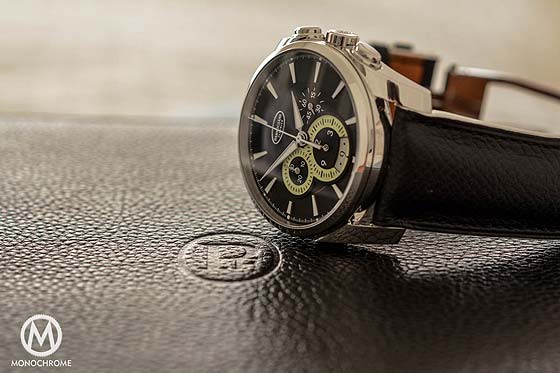Parmigiani is a relatively new name breitling replica sale for men in the world of high-end timepieces. The brand has remained a niche player for its first 18 years, and has focused exclusively on the absolute top end of haute horlogerie. Just think of Parmigiani’s Bugatti watches, its minute repeaters and the recently introduced skeleton version of one of our favorite dress watches on the market, the Tonda 1950 Squelette. Today, we at Monochrome Watchestake a closer look at the Parmigiani Tonda Metrographe, introduced last year.
Parmigiani’s Tonda collection comprises watches with round cases, something that might be more or less standard for most brands out there, but not so for Parmigiani. The Tonda 1950 won our hearts because of its quirkiness, with its rather unusual, outsize lugs. Similar design cues can be found in the Bugatti Aerolithe and Tonda Metrographe – the latter of which we had the pleasure to wear for a week.
The design is a mix of classic design codes and some quirky ingredients. The recognizable Parmigiani lugs – which I happen to like a lot, but I can imagine these could be described as “polarizing” – are there, and there’s a green, luminescent figure “8” formed by the two round subdials that are the chronograph registers. The luminescent material used for these two circles is green, instead of the white luminescent material that is used on the regular hours markers and hands. It looks great, and the green eight immediately catches the attention. There are two other dial versions: one in mint green with only white luminescent material, and one in grained white with only luminescent hands (no luminescent material on the hour markers and no “8”).
The green, luminescent “8” is hard to miss. As you would probably expect, it shines brightly during the darker hours — really brightly — which looks very cool. However, it also prevents the wearer from properly reading the time during these darker hours. While either or both hands are moving over the luminescent “8” the hand(s) cannot be distinguished from the very bright subdials in the background, and it makes for one bright “8.” While not very practical, it does give the dial of this particular model an interesting look.
The black dial has applied hour markers, executed in white gold, and filled with white luminescent material. At the 3 o’clock position is the subdial for the small running seconds, and inside the chronograph’s hour totalizer is an aperture for the date. At the 12 o’clock position is the applied brand logo that adorns all dials from Parmigiani Fleurier.
The stainless steel case measures 40 mm in diameter and is roughly 12 mm thick (quite thin for a chronograph). In my opinion, a perfect dimension for the dressy/sporty watch that the Parmigiani Tonda Metrographe actually is, especially this version on the black leather strap. And in case you are wondering, wonder, no, it is not alligator leather, but a calf leather strap made by none other than Hèrmes. The Parmigiani Tonda Metrographe wears very comfortably, and the relatively wide leather tag heuer replica watches strap adds to its bold and masculine look.
The photo above shows that the sides of the lugs are beautifully mirror-polished and are shaped to follow the curving of the wrist. The photo also shows the first indication that we’re dealing with a chronograph module. This is something to remember: when the crown is lower than the chronograph pushers, that means a chronograph module has been placed on top of the movement. With an integrated chronograph movement, the crown and pushers are aligned.
That brings us to the movement, Caliber PF315, which is a in-house developed and manufactured movement that indicates time and date. This movement has two series-coupled mainspring barrels, which together hold 42 hours of autonomy when fully wound. For the critical reader, this might sound strange. Most movements with a single mainspring offer 42 hours of power reserve, so why does a movement with two main springs, coupled in series, deliver exactly the same? There’s a perfectly good reason for this, and one that testifies that Parmigiani Fleurier is doing a proper job when it comes to high-end watchmaking. It involves constant power and the quest for perfect chronometric rates.
With all mechanical timepieces, there’s a simple rule. The power, coming from the mainspring and going through the gear train to the escapement, has to be as stable as possible to ensure good chronometric rates (and thus close to perfect timing.) Since every spring has more torque when it’s fully loaded, and less torque when the spring is close to being unwound, the power coming from the mainspring varies. To compensate for this variation, a constant-force mechanism is an option. Another option is to use an abundance of potential power (in this case, two coupled mainsprings) and cut of the power supply at the point where the torque drops below certain values. This ensures a relatively stable source of power for the movement, and thus superlative timing.
The movement ticks at a frequency of 28,800 vph (4 Hz), has 46 jewels in total and 351 components (that’s including the Dubois-Dépraz chronograph module). The finishing is beautiful, and all done by hand: côtes de Genève on the bridges, which are also beveled and feature polished angles, perlage on the mainplate. The movement comes from the Vaucher manufacture, which is owned by Parmigiani.
Monochrome Monday: Reviewing the iwc replica latest Parmigiani Tonda Metrographe | WatchTime – USA’s No.1 Watch Magazine